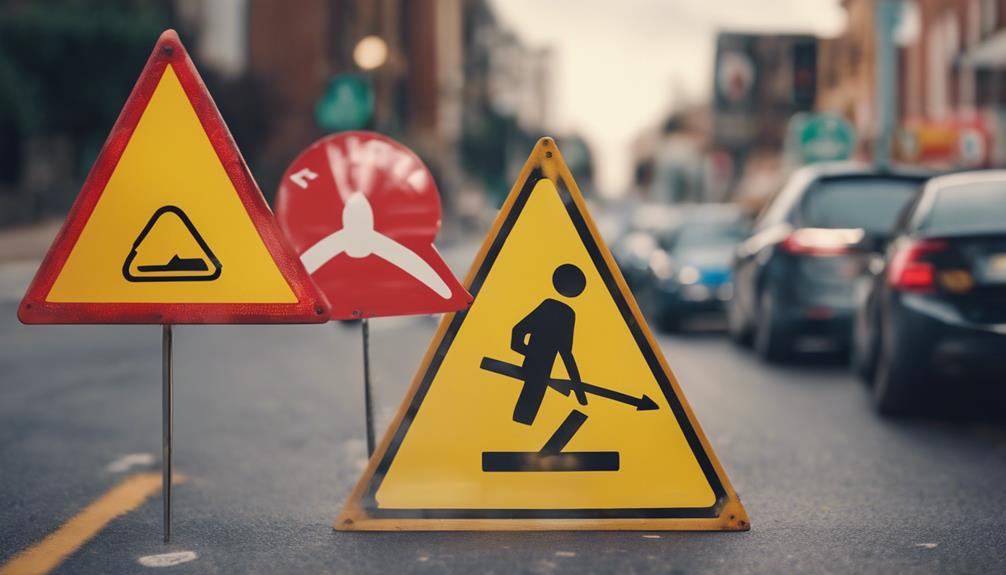Understanding triangle road signs is essential for safe driving. These signs have red and white colors and are strategically placed at intersections. Yield signs indicate giving the right of way and are vital for safe driving practices. Regulatory triangle signs convey state laws, while warning signs alert to potential hazards. Railway crossing signs demand attention, especially to trains. School zone signs remind drivers to slow down. Reflective triangle signs improve visibility, especially at night. These signs promote safety and prevent accidents. Exploring further will deepen your knowledge of road sign meanings and driving safety.
Key Takeaways
- Triangle road signs indicate specific regulations and warnings.
- Different shapes and colors represent various meanings.
- Yield signs require drivers to give right of way.
- Reflective materials enhance visibility, especially at night.
- Understanding these signs is crucial for safe driving practices.
Triangle Road Signs Overview
In this section, we'll explore the significance and impact of triangle road signs on driver behavior and road safety.
Triangle road signs, specifically those with an equilateral triangular shape, are vital indicators for drivers to yield the right of way. The distinct red and white colors of these signs immediately catch the eye, signaling to drivers that they must be prepared to yield to oncoming traffic or pedestrians.
Dating back to 1950 in Tulsa, Oklahoma, the evolution of the inverted triangle Yield sign highlights its enduring importance in road safety. These signs are strategically positioned at intersections to guide drivers on proper right-of-way procedures, promoting safe interactions and reducing the risk of accidents.
Understanding the meaning behind these triangle road signs is essential for all drivers, as it ensures smooth and efficient navigation through intersections, fostering a safer driving environment for everyone on the road.
Yield Sign Meaning

Yield signs are vital for traffic safety. They serve to indicate where drivers need to yield the right of way to other vehicles. Understanding the function, rules, and design of yield signs is essential for safe driving practices.
Yield signs help regulate traffic flow and prevent accidents by ensuring that drivers give way to others when necessary. It is crucial for all road users to obey yield signs to maintain a safe and efficient traffic environment.
Yield Sign Function
Triangle road signs like the yield sign are vital elements in promoting safe driving practices at intersections. When it comes to the function of yield signs, they play an important role in ensuring smooth traffic flow and preventing accidents.
Here are three key points to keep in mind:
- Preparation: Yield signs prepare drivers to give the right of way to others, whether they're vehicles or pedestrians.
- Safety: By yielding at intersections, drivers reduce conflicts and enhance overall safety on the road.
- Clarity: Placing yield signs strategically helps in preventing misunderstandings and promotes orderly traffic interactions among drivers.
Yield Sign Rules
Understanding the rules of yielding at intersections is essential for safe and efficient driving practices. Traffic laws dictate that when approaching a yield sign, drivers must slow down, be prepared to stop, and yield the right-of-way to oncoming vehicles or pedestrians. Here is a quick reference table summarizing key yield sign rules:
| Yield Sign Rules | Description |
|---|---|
| Yield to Oncoming Traffic | Slow down and give way to vehicles approaching from the opposite direction. |
| Yield to Pedestrians | Stop and allow pedestrians to cross safely. |
| Yield when Merging | Merge into traffic smoothly and yield to vehicles already on the highway. |
| Yield to Emergency Vehicles | Pull over and give way to emergency vehicles with sirens and flashing lights. |
Yield Sign Design
Examining the configuration and symbolism of yield signs sheds light on their significance in guiding safe driving practices at intersections. When it comes to yield sign design, there are key elements to take into account:
- Triangle Road Signs: The equilateral triangle shape is universally associated with yielding at intersections.
- Red Border: The red and white color scheme with a red border makes yield signs easily identifiable.
- Safety Priority: Yield signs prompt drivers to allow others to proceed first, prioritizing safety and enhancing traffic flow.
Understanding the design and meaning of yield signs is essential for ensuring smooth and safe interactions at intersections. Remember, yielding is about being courteous and responsible on the road.
Regulatory Triangle Signs

When driving, it is important to pay close attention to regulatory triangle signs that convey specific state laws regarding speed limits and parking regulations. These signs, featuring a white background with black or colored lettering, play a significant role in informing drivers about regulatory requirements on the road. They are rectangular or square in shape and are essential for maintaining order and safety by clearly stating laws and rules that drivers must follow. Regulatory triangle signs communicate turning rules, speed limits, parking restrictions, and other important regulatory information to drivers. Their distinct design helps drivers quickly identify and understand the specific laws applicable in a given area.
| Regulatory Triangle Signs | Description |
|---|---|
| Shape | Rectangular or square |
| Background | White |
| Lettering | Black or colored |
| Purpose | Convey state laws |
| Information | Speed limits, parking rules |
Understanding these signs is crucial for all drivers to ensure compliance with state laws and contribute to safer roads for everyone.
Warning Triangle Signs

Warning triangle signs are essential for alerting drivers to potential hazards on the road. These signs often feature symbols like curves, turns, or dips to indicate specific dangers ahead.
It's important for drivers to pay attention to these signs for their safety and the safety of others on the road.
Common Shapes Used
Upon seeing a triangle road sign, one immediately recognizes the 'Yield' message it conveys, as the triangle shape, with its distinctive upside-down orientation, stands out with its red or white coloring and red border. When it comes to warning signs, the triangle is a powerful shape that commands attention. Here are three key points about common triangle road signs: These triangles are often placed at intersections or merge points, signaling drivers to slow down and give way to approaching traffic. The use of such shapes is consistent across many countries, including road sign shapes in Ireland, where triangular signs are also employed primarily for warnings or to denote the need to yield. In this way, road sign shapes in Ireland and elsewhere serve as a universal language that ensures road safety and clear communication for drivers.
- Guarantee Message: Triangle signs exclusively communicate instructions to yield to other drivers, promoting safety and smooth traffic flow.
- Uniformity: All sides of the triangle road sign are equal, aiding in quick recognition and understanding of the message.
- Color Coding: The use of red or white coloring with a red border on these signs enhances visibility and guarantees the message is clear and easily comprehensible.
Safety Precautions Highlighted
To enhance road safety, understanding the meanings of warning triangle signs is essential for adapting our driving behavior and preventing accidents.
Warning triangle signs are diamond-shaped and colored yellow or orange to alert drivers of dangerous or unusual road conditions. They typically display black letters or symbols to provide clear warnings about curves, turns, dips, and other potential hazards on the road ahead.
These signs play a vital role in enhancing road safety by offering advance notice of upcoming dangers. By recognizing and heeding these warnings, drivers can take necessary precautions to navigate the road safely and avoid accidents.
Paying attention to warning triangle signs is a proactive way to guarantee a secure driving experience for everyone on the road.
Railway Crossing Sign Explanation

As drivers approach a railway crossing sign, we must be vigilant and prepared to yield to oncoming trains for our safety. These signs serve as important warnings, demanding our attention and respect.
Here's what you need to know about railway crossing signs:
- Distinctive Design: Railway crossing signs are diamond-shaped, resembling yield signs, and feature a prominent crossbuck symbol. Their appearance is intentional to catch our eye and signal the need for caution.
- Yielding Responsibility: When encountering a railway crossing sign, drivers must be ready to yield to any approaching trains. This means being prepared to stop if necessary, ensuring the safe passage of the train.
- Safety First: The primary purpose of these signs is to promote safety at roadway-railway intersections. By obeying these signs and yielding to trains, we play a crucial role in preventing accidents and keeping ourselves and others safe on the road.
School Zone Triangle Signs

When driving through school zones, we must pay close attention to the pentagon-shaped triangle signs that signify pedestrian crossings. These school zone signs are designed with a pentagon shape to alert drivers to the presence of children and school-related activities.
The color combination of yellow and black is commonly used for these signs to guarantee high visibility and capture the attention of drivers. These signs play a vital role in reminding drivers to slow down, watch for children, and be extra cautious in school areas.
In addition to the pentagon shape and color scheme, school zone triangle signs often feature symbols like children walking or a school bus to further emphasize the need for caution. By understanding and obeying these signs, we can contribute to the safety of pedestrians, especially children, in school zones.
Always remember to reduce your speed, stay alert, and prioritize safety when encountering school zone triangle signs on the road.
Customization Options Available

We offer a range of customization options for triangle road signs, allowing customers to tailor their signage to specific requirements. When customizing your road sign, consider the following:
- Sizes: Choose from a variety of size options to guarantee your sign is visible and fits the designated area perfectly.
- Mounting Choices: Select the most suitable mounting option for your road sign, whether it's post-mounted, wall-mounted, or freestanding.
- Vinyl Specifications: Customize the vinyl specifications to meet your specific needs, ensuring durability and longevity for your road sign.
These customization options not only provide flexibility in design but also cater to various road sign requirements. Whether you need simple text-only signs or complex designs, our customization services offer the versatility to meet your unique signage needs.
Additionally, our draft design approval process ensures that your custom road sign meets regulations and your satisfaction.
Importance of Reflective Triangle Signs

Why do reflective triangle signs play an important role in road safety?
Reflective triangle signs are essential for enhancing visibility, especially during nighttime and in low light conditions. These signs utilize retroreflective materials that bounce light back to drivers, making them more noticeable and improving recognition.
The Federal Highway Administration's Manual mandates the use of retroreflectivity classes like RA1, RA2, and RA3 to guarantee compliance with safety standards. By incorporating these materials, reflective triangle signs greatly contribute to road safety by reducing accidents and guiding drivers effectively.
It's essential to maintain these signs properly to ensure excellent performance and longevity. Understanding the significance of reflective triangle signs and their role in road safety is crucial for all road users. By adhering to regulations and ensuring the visibility of these signs, we can collectively work towards safer roads for everyone.
Frequently Asked Questions
What Do the Triangle Road Signs Mean?
Triangle road signs mean Yield.
They're easily recognizable by their upside-down triangle shape with all sides equal.
These signs are colored red or white with a red border and are exclusively used to convey the message to yield.
Yield signs date back to 1925 and aim to prevent conflicts at intersections by instructing drivers to allow others to go first.
Following Yield signs promotes safe traffic flow and prevents accidents.
What Are the 7 Different Shapes of Traffic Signs and What Purpose Do Each of Them Mean?
When we talk about traffic signs, there are seven main shapes to pay attention to. Each shape serves a specific purpose in conveying important messages to drivers. These shapes include circle, triangle, square, rectangle, pentagon, octagon, and diamond.
Understanding the meaning behind each shape helps drivers navigate the roads more effectively and safely. By recognizing these shapes, we can better understand the rules and regulations of the road.
What Does the Upside Down Triangle Traffic Sign Mean?
When approaching an upside-down triangle traffic sign, remember it indicates yielding.
The unique shape and red or white color with a red border make it easily recognizable.
This design exclusively conveys the message of yielding at intersections.
It serves as a universal symbol for drivers to slow down and yield when necessary.
Always be attentive to these signs to guarantee safety on the road.
What Is the Cross in Triangle Road Sign?
The cross in a triangle road sign indicates an upcoming railway crossing, warning drivers to yield to oncoming trains. It's vital to give right of way at these intersections and stop if needed for safety.
The color of the cross often matches the border of the sign, enhancing visibility. This visual cue is key for prioritizing caution and ensuring safe navigation through railway crossings.
Conclusion
In summary, understanding triangle road signs is essential for safe driving. As the saying goes, 'better safe than sorry,' knowing the meanings of yield, regulatory, warning, railway crossing, and school zone signs can help prevent accidents and keep everyone on the road safe.
Remember, always pay attention to these signs and follow their instructions to guarantee a smooth and secure journey. Stay informed, stay alert, and stay safe on the road.










